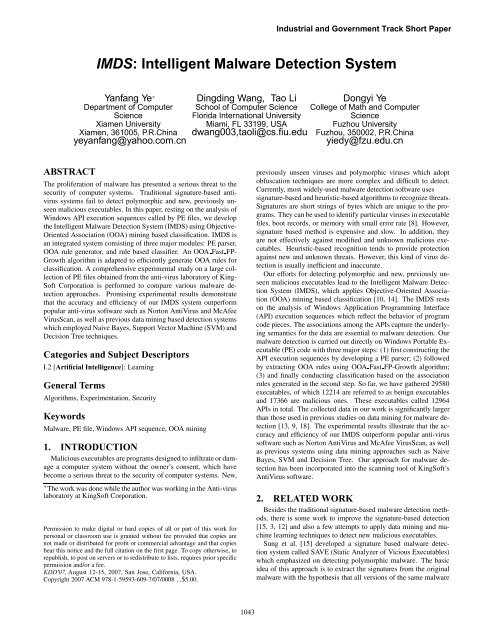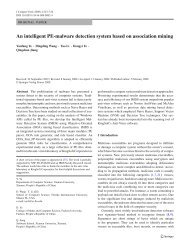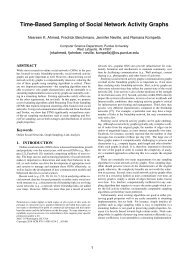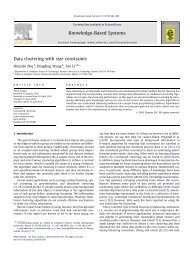IMDS: Intelligent Malware Detection System - Florida International ...
IMDS: Intelligent Malware Detection System - Florida International ...
IMDS: Intelligent Malware Detection System - Florida International ...
Create successful ePaper yourself
Turn your PDF publications into a flip-book with our unique Google optimized e-Paper software.
Industrial and Government Track Short Paper<br />
<strong>IMDS</strong>: <strong>Intelligent</strong> <strong>Malware</strong> <strong>Detection</strong> <strong>System</strong><br />
Yanfang Ye ∗<br />
Department of Computer<br />
Science<br />
Xiamen University<br />
Xiamen, 361005, P.R.China<br />
yeyanfang@yahoo.com.cn<br />
Dingding Wang, Tao Li Dongyi Ye<br />
School of Computer Science College of Math and Computer<br />
<strong>Florida</strong> <strong>International</strong> University<br />
Science<br />
Miami, FL 33199, USA<br />
Fuzhou University<br />
dwang003,taoli@cs.fiu.edu Fuzhou, 350002, P.R.China<br />
yiedy@fzu.edu.cn<br />
ABSTRACT<br />
The proliferation of malware has presented a serious threat to the<br />
security of computer systems. Traditional signature-based antivirus<br />
systems fail to detect polymorphic and new, previously unseen<br />
malicious executables. In this paper, resting on the analysis of<br />
Windows API execution sequences called by PE files, we develop<br />
the <strong>Intelligent</strong> <strong>Malware</strong> <strong>Detection</strong> <strong>System</strong> (<strong>IMDS</strong>) using Objective-<br />
Oriented Association (OOA) mining based classification. <strong>IMDS</strong> is<br />
an integrated system consisting of three major modules: PE parser,<br />
OOA rule generator, and rule based classifier. An OOA Fast FP-<br />
Growth algorithm is adapted to efficiently generate OOA rules for<br />
classification. A comprehensive experimental study on a large collection<br />
of PE files obtained from the anti-virus laboratory of King-<br />
Soft Corporation is performed to compare various malware detection<br />
approaches. Promising experimental results demonstrate<br />
that the accuracy and efficiency of our <strong>IMDS</strong> system outperform<br />
popular anti-virus software such as Norton AntiVirus and McAfee<br />
VirusScan, as well as previous data mining based detection systems<br />
which employed Naive Bayes, Support Vector Machine (SVM) and<br />
Decision Tree techniques.<br />
Categories and Subject Descriptors<br />
I.2 [Artificial Intelligence]: Learning<br />
General Terms<br />
Algorithms, Experimentation, Security<br />
Keywords<br />
<strong>Malware</strong>, PE file, Windows API sequence, OOA mining<br />
1. INTRODUCTION<br />
Malicious executables are programs designed to infiltrate or damage<br />
a computer system without the owner’s consent, which have<br />
become a serious threat to the security of computer systems. New,<br />
∗ The work was done while the author was working in the Anti-virus<br />
laboratory at KingSoft Corporation.<br />
Permission to make digital or hard copies of all or part of this work for<br />
personal or classroom use is granted without fee provided that copies are<br />
not made or distributed for profit or commercial advantage and that copies<br />
bear this notice and the full citation on the first page. To copy otherwise, to<br />
republish, to post on servers or to redistribute to lists, requires prior specific<br />
permission and/or a fee.<br />
KDD'07,August 12-15, 2007, San Jose, California, USA.<br />
Copyright 2007 ACM 978-1-59593-609-7/07/0008 ...$5.00.<br />
previously unseen viruses and polymorphic viruses which adopt<br />
obfuscation techniques are more complex and difficult to detect.<br />
Currently, most widely-used malware detection software uses<br />
signature-based and heuristic-based algorithms to recognize threats.<br />
Signatures are short strings of bytes which are unique to the programs.<br />
They can be used to identify particular viruses in executable<br />
files, boot records, or memory with small error rate [8]. However,<br />
signature based method is expensive and slow. In addition, they<br />
are not effectively against modified and unknown malicious executables.<br />
Heuristic-based recognition tends to provide protection<br />
against new and unknown threats. However, this kind of virus detection<br />
is usually inefficient and inaccurate.<br />
Our efforts for detecting polymorphic and new, previously unseen<br />
malicious executables lead to the <strong>Intelligent</strong> <strong>Malware</strong> <strong>Detection</strong><br />
<strong>System</strong> (<strong>IMDS</strong>), which applies Objective-Oriented Association<br />
(OOA) mining based classification [10, 14]. The <strong>IMDS</strong> rests<br />
on the analysis of Windows Application Programming Interface<br />
(API) execution sequences which reflect the behavior of program<br />
code pieces. The associations among the APIs capture the underlying<br />
semantics for the data are essential to malware detection. Our<br />
malware detection is carried out directly on Windows Portable Executable<br />
(PE) code with three major steps: (1) first constructing the<br />
API execution sequences by developing a PE parser; (2) followed<br />
by extracting OOA rules using OOA Fast FP-Growth algorithm;<br />
(3) and finally conducting classification based on the association<br />
rules generated in the second step. So far, we have gathered 29580<br />
executables, of which 12214 are referred to as benign executables<br />
and 17366 are malicious ones. These executables called 12964<br />
APIs in total. The collected data in our work is significantly larger<br />
than those used in previous studies on data mining for malware detection<br />
[13, 9, 18]. The experimental results illustrate that the accuracy<br />
and efficiency of our <strong>IMDS</strong> outperform popular anti-virus<br />
software such as Norton AntiVirus and McAfee VirusScan, as well<br />
as previous systems using data mining approaches such as Naive<br />
Bayes, SVM and Decision Tree. Our approach for malware detection<br />
has been incorporated into the scanning tool of KingSoft’s<br />
AntiVirus software.<br />
2. RELATED WORK<br />
Besides the traditional signature-based malware detection methods,<br />
there is some work to improve the signature-based detection<br />
[15, 3, 12] and also a few attempts to apply data mining and machine<br />
learning techniques to detect new malicious executables.<br />
Sung et al. [15] developed a signature based malware detection<br />
system called SAVE (Static Analyzer of Vicious Executables)<br />
which emphasized on detecting polymorphic malware. The basic<br />
idea of this approach is to extract the signatures from the original<br />
malware with the hypothesis that all versions of the same malware<br />
1043
Industrial and Government Track Short Paper<br />
share a common core signature. Schultz et al. [13] applied Naive<br />
Bayes method to detect previously unknown malicious code. Decision<br />
Tree was studied in [18, 9]. Kolter et al. [9] gathered 1971<br />
benign executables and 1651 malicious executables in Windows<br />
PE format, and examined the performance of different classifiers<br />
such as Naive Bayes, support vector machine (SVM) and Decision<br />
Tree using 10-fold cross validation and plotting ROC curves [16].<br />
Their results also showed that the ROC curve of the Decision Tree<br />
method dominated all others.<br />
Different from earlier studies, our work is based on a large collection<br />
of malicious executables collected at KingSoft Anti-Virus<br />
Laboratory. In addition, we apply OOA mining technique to extract<br />
the characterizing frequent patterns to achieve accurate malware<br />
detection since frequent patterns found by association mining<br />
carry the underlying semantics of the data.<br />
third party binary compress toll, it needs to be decompressed before<br />
being passed to the PE parser. Through the API query database,<br />
the API execution sequence generated by the PE parser can be converted<br />
to a group of 32-bit global IDs which represents the static<br />
execution sequence of the corresponding API functions. Then we<br />
use the API calls as the signatures of the PE files and store them in<br />
the signature database, which contains 6 fields: record ID, PE file<br />
name, file type (“0” represents benign file while “1” is for malicious<br />
file), called API sequence name, called API ID, and the total<br />
number of called API functions, as shown in Figure 2. After that,<br />
an OOA mining algorithm is applied to generate class association<br />
rules which are recorded in the rule database. To finally determine<br />
whether a PE file is malicious or not, we pass the selected API calls<br />
together with the rules generated to the malware detection module<br />
to perform the association rule based classification.<br />
3. THE SYSTEM ARCHITECTURE<br />
Our <strong>IMDS</strong> system is performed directly on Windows PE code.<br />
PE is designed as a common file format for all flavors of Windows<br />
operating system, and PE viruses are in the majority of the viruses<br />
rising in recent years. Some famous viruses such as CIH, CodeRed,<br />
CodeBlue, Nimda, Sircam, Killonce, Sobig, and LoveGate all aim<br />
at PE files. The system consists of three major components: PE<br />
parser, OOA rule generator, and malware detection module, as illustrated<br />
in Figure 1.<br />
Figure 2: Samples in the signature database<br />
Figure 1: <strong>IMDS</strong> system architecture<br />
The functionality of the PE parser is to generate the Windows<br />
API execution sequence for each benign/malicious executable. Since<br />
a virus scanner is usually a speed sensitive application, in order to<br />
improve the system performance, we developed a PE parser to construct<br />
the API execution sequences of PE files instead of using a<br />
third party disassembler. If a PE file is previously compressed by a<br />
4. CLASSIFICATION BASED ON OOA<br />
MINING<br />
Both classification and association mining play important roles<br />
in data mining techniques. Classification is “the task of learning a<br />
target function that maps each feature set to one of the predefined<br />
class labels” [17]. For association rule mining, there is no predetermined<br />
target. Given a set of transactions in the database, all<br />
the rules that satisfied the support and confidence thresholds will<br />
be discovered [1]. As a matter of fact, classification and association<br />
rule mining can be integrated to association rule based classification<br />
[10, 2]. This technique utilizes the properties of frequent<br />
patterns to solve the scalability and overfitting issues in classification<br />
and achieves excellent accuracy [2]. In our <strong>IMDS</strong> system, we<br />
adapted OOA mining techniques [14] to generate the rules.<br />
4.1 OOA Definitions<br />
In our <strong>IMDS</strong> system, the goal is to find out how a set of API calls<br />
supports the specific objectives: Obj 1 = (Group = Malicious),<br />
and Obj 2 = (Group = Benign).<br />
• Definition 1 (Support and confidence) Let I = {I 1, ..., I m}<br />
be an itemset and I → Obj(os%, oc%) be an association<br />
rule in OOA mining. The support and confidence of the rule<br />
are defined as:<br />
count(I ∪ {Obj}, DB)<br />
os% = supp(I, Obj) = × 100%<br />
|DB|<br />
oc% = conf(I, Obj) =<br />
count(I ∪ {Obj}, DB)<br />
count(I, DB)<br />
× 100%<br />
1044
Industrial and Government Track Short Paper<br />
where the function count(I ∪{Obj}, DB) returns the number<br />
of records in the dataset DB where I ∪ {Obj} holds.<br />
• Definition 2 (OOA frequent itemset) Given mos% as a<br />
user-specified minimum support. I is an OOA frequent itemset/pattern<br />
in DB if os% ≥ mos%.<br />
• Definition 3 (OOA rule) Given moc% as a user-specified<br />
confidence. Let I = {I 1, ..., I m} be an OOA frequent itemset.<br />
I → Obj(os%, oc%) is an OOA rule if oc% ≥ moc%.<br />
4.2 OOA Fast FP-Growth Algorithm<br />
Although Apriori algorithm can be extended to OOA mining,<br />
it requires many iterations to generate all of the frequent itemsets<br />
before generating the association rules. An alternative OOA mining<br />
algorithm called OOA FP-Growth is designed based on FP-Growth<br />
algorithm [6, 5]. In general, OOA FP-Growth algorithm is much<br />
faster than OOA Apriori for mining frequent itemsets. However,<br />
when the minimum support is small, OOA FP-Growth generates a<br />
huge number of conditional FP-trees recursively, which is time and<br />
space consuming. Our malware detection relies on finding frequent<br />
patterns from large collections of data, therefore, the efficiency is<br />
an essential issue to our system. In our <strong>IMDS</strong> system, we extend a<br />
modified FP-Growth algorithm proposed in [4] to conduct the OOA<br />
mining. This algorithm greatly reduces the costs of processing time<br />
and memory space, and we call it OOA Fast FP-Growth algorithm.<br />
Similar to OOA FP-Growth algorithm, there are also two steps in<br />
OOA Fast FP-Growth algorithm: constructing an OOA Fast FPtree<br />
and generating frequent patterns from the tree. But the structure<br />
of an OOA Fast FP-tree is different from that of an OOA FPtree<br />
in the following way: (1) The paths of an OOA Fast FP-tree<br />
are directed, and there is no path from the root to leaves. Thus,<br />
fewer pointers are needed and less memory space is required. (2)<br />
In an OOA FP-tree, each node is the name of an item, but in an<br />
OOA Fast FP-tree, each node is the sequence number of an item,<br />
which is determined by the support count of the item. The detailed<br />
description can be referenced in [4].<br />
4.3 An Illustrating Example<br />
At the beginning of this section, we state that frequent patterns<br />
are essential to accurate classification. To demonstrate the effectiveness<br />
of the frequent patterns, we show an example rule generated<br />
by OOA Fast FP-Growth algorithm. We sample 5611 records<br />
from our signature database, of which 3394 records are malicious<br />
executables and 2217 records are benign executables. One of the<br />
rules we generated is:<br />
(2230, 398, 145, 138, 115, 77) → Obj 1 = (Group = Malicious)<br />
(os = 0.296739, oc = 0.993437),<br />
where os and oc represent the support and confidence, respectively.<br />
After converting the API IDs to API names via our API query<br />
database, this rule becomes:<br />
(KERNEL32.DLL, OpenP rocess; CopyF ileA; CloseHandle;<br />
GetV ersionExA; GetModuleF ileNameA; W riteF ile; ) →<br />
Obj 1 = (Group = Malicious) (os = 0.296739, oc = 0.993437).<br />
After analyzing the API sequence in this rule, we know that the program<br />
actually executes the following functions: (i) returns a handle<br />
to an existing process object; (ii) copies an existing file to a new<br />
file; (iii) closes the handle of the open object; (iv) obtains extended<br />
information about the version of the currently running operating<br />
system; (v) retrieves the complete path of the file that contains the<br />
specified module of current process; and (vi) writes data to the file.<br />
with the os and oc values, we know that this sequence of API appears<br />
in 1665 malware, while only in 11 benign files. Obviously, it<br />
is one of the essential rules for determining whether an executable<br />
is malicious or not. In the experiments section, we perform a comprehensive<br />
experimental study to evaluate the efficiency of different<br />
OOA mining algorithms.<br />
4.4 Associative Classifier<br />
For OOA rule generation, we use the OOA Fast FP-Growth algorithm<br />
to obtain all the association rules with certain support and<br />
confidence thresholds, and two objectives: Obj 1<br />
= (Group = Malicious), Obj 2 = (Group = Benign). Then<br />
we apply the technique of classification based on association rules<br />
(CBA) to build a CBA classifier [10] as our malware detection module.<br />
The CBA classifier is built on rules with high support and<br />
confidence and uses the association between frequent patterns and<br />
the type of files for prediction. So, our malware detection module<br />
takes the input of generated OOA rules and outputs the prediction<br />
of whether an executable is malicious or not.<br />
5. DATA COLLECTION<br />
As stated previously, we obtained 29580 Windows PE files of<br />
which 12214 were recognized as benign executables while 17366<br />
were malicious executables. The malicious executables mainly consisted<br />
of backdoors, worms, and Trojan horses and all of them<br />
were provided by the Anti-virus laboratory of KingSoft Corporation.<br />
The benign executables were gathered from the system files<br />
of Windows 2000/NT and XP operating system.<br />
6. EXPERIMENTAL RESULTS AND<br />
ANALYSIS<br />
We conduct three sets of experiments using our collected data.<br />
In the first set of experiments, we evaluate the efficiency of different<br />
OOA mining algorithms. The second set of experiments is to<br />
compare the abilities to detect polymorphic and unknown malware<br />
of our <strong>IMDS</strong> system with current widely-used anti-virus software.<br />
The efficiency and false positives by using different scanners have<br />
also been examined. Finally, we compare our <strong>IMDS</strong> system with<br />
other classification based methods. All the experiments are conducted<br />
under the environment of Windows 2000 operating system<br />
plus Intel P4 1Ghz CPU and 1Gb of RAM.<br />
6.1 Evaluation of Different OOA Mining<br />
Algorithms<br />
In the first set of experiments, we implement OOA Apriori,<br />
OOA FP-Growth, and OOA Fast FP-Growth algorithms under Microsoft<br />
Visual C++ environment. We sample 5611 records from our<br />
signature database, which includes 3394 records of malicious executables<br />
and 2217 records of benign executables. By using different<br />
support and confidence thresholds, we compare the efficiency<br />
of the three algorithms. The results are shown in Table 3 and Figure<br />
3. From Table 3, we observe that the time complexity increases<br />
exponentially as the minimum support threshold decreases. However,<br />
it shows obviously that the OOA Fast FP-Growth algorithm<br />
is much more efficient than the other two algorithms, and it even<br />
doubles the speed of performing OOA FP-Growth algorithm. Figure<br />
3 presents a clearer graphical view of the results.<br />
6.2 Comparisons of Different Anti-virus<br />
Scanners<br />
In this section, we examine the abilities of detecting polymorphic<br />
malware and unknown malware of our system in comparison<br />
with some of the popular software tools such as Norton AntiVirus<br />
2006, Dr.Web, McAfee VirusScan and Kaspersky Anti-Virus. The<br />
efficiency and the number of false positives are also evaluated.<br />
1045
Industrial and Government Track Short Paper<br />
Experiment 1 2 3 4<br />
mos 0.355 0.35 0.34 0.294<br />
moc 0.9 0.95 0.9 0.98<br />
OOA Apriori 25 260.5 ∞ ∞<br />
OOA FP-Growth 8 16.14 60.5 280.2<br />
OOA Fast FP-Growth 4.1 7.99 28.8 143.5<br />
Table 1: Running time of different OOA mining algorithms<br />
(min). mos and moc represent the minimum support and minimum<br />
confidence for each experiment.<br />
Software N M D K <strong>IMDS</strong><br />
√ √ √ √ √<br />
Beagle<br />
√ √ √ √<br />
Beagle V1<br />
√ ×<br />
√ √<br />
Beagle V2 × ×<br />
Beagle V3 × × × √ √<br />
√ √ √<br />
Beagle V4<br />
√ √ √ ×<br />
√ ×<br />
√<br />
Blaster<br />
√ √ √ √ √<br />
Blaster V1<br />
√<br />
Blaster V2<br />
√<br />
×<br />
√<br />
×<br />
√<br />
×<br />
√<br />
×<br />
√<br />
Lovedoor<br />
Lovedoor V1 × × √ √<br />
×<br />
√<br />
Lovedoor V2 × × × ×<br />
Lovedoor V3 × √ × √ √<br />
√ √ √ √ √<br />
Mydoom<br />
√<br />
Mydoom V1 × × × ×<br />
√<br />
Mydoom V1 × × × ?<br />
Table 2: Polymorphic malware detection. Remark: N - Norton<br />
AntiVirus, M - MacAfee, D - Dr.Web, K - Kaspersky. In the<br />
table, “ √ ” indicates successful detection, “×” indicates failure<br />
to detect, and “?” represents only an “alert”; all the scanners<br />
used are of most current and updated version.<br />
Figure 3: Comparison on the efficiency of different OOA mining<br />
algorithms<br />
6.2.1 Polymorphic Virus <strong>Detection</strong><br />
In this experiment, we sample 3000 malicious files and 2000 benign<br />
files in the training data set, then we use 1500 malware and<br />
500 benign executables as the test data set. Several recent Win32<br />
PE viruses are included in the test data set for analysis such as<br />
Lovedoor, My doom, Blaster, and Beagle. For each virus, we apply<br />
the obfuscation techniques described in [15] to create a set of<br />
polymorphic versions. Then we compare our system with current<br />
most widely-used anti-virus software. The results shown in Table<br />
4 demonstrate that our <strong>IMDS</strong> system achieves better accuracy than<br />
other software in polymorphic malware detection.<br />
6.2.2 Unknown <strong>Malware</strong> <strong>Detection</strong><br />
In order to examine the ability of identifying new and previously<br />
unknown malware of our <strong>IMDS</strong> system, in the test data set, we use<br />
1000 malware analyzed by the experts in KingSoft Anti-virus laboratory,<br />
while the signatures of the malware have not been recorded<br />
into the virus signature database. Comparing with other anti-virus<br />
software, our <strong>IMDS</strong> system performs most accurate detection. The<br />
results are listed in Table 5.<br />
6.2.3 <strong>System</strong> Efficiency and False Positives<br />
In malware detection, a false positive occurs when the scanner<br />
marks a benign file as a malicious one by error. False positives<br />
can be costly nuisances due to the waste of time and resources to<br />
deal with those falsely reported files. In this set of experiments,<br />
in order to examine the system efficiency and the number of false<br />
positives of the <strong>IMDS</strong> system, we sample 2000 executables in the<br />
test data set, which contains 500 malicious executables and 1500<br />
benign ones.<br />
First, we compare the efficiency of our system with different<br />
scanners including the scanner named “SAVE” [15, 20] described<br />
in related work and some widely-used anti-virus software.<br />
The results in Figure 4 illustrate that our <strong>IMDS</strong> system achieves<br />
much higher efficiency than other scanners when being executed<br />
Software N M D K <strong>IMDS</strong><br />
√ √ √<br />
√<br />
malware1<br />
√ √<br />
×<br />
√<br />
malware2<br />
√<br />
× ×<br />
√<br />
malware3<br />
× × ×<br />
malware4 ×<br />
√<br />
× × ×<br />
√<br />
×<br />
malware5 ×<br />
√<br />
× ×<br />
√<br />
malware6<br />
√<br />
× ×<br />
×<br />
√<br />
malware7<br />
× × ×<br />
√<br />
malware8 ×<br />
√<br />
×<br />
√<br />
× ×<br />
√<br />
malware9 ×<br />
×<br />
√<br />
malware10 × × ×<br />
√<br />
×<br />
√<br />
malware11 ×<br />
√<br />
× ×<br />
√ √<br />
malware12 ×<br />
×<br />
.<br />
.<br />
.<br />
.<br />
.<br />
√<br />
√<br />
.<br />
malware1000<br />
× × ×<br />
Stat. 633 753 620 780 920<br />
Ratio. 63.3% 75.3% 62% 78% 92%<br />
Table 3: Unknown malware detection<br />
in the same environment. The number of false positives by using<br />
different scanners are also examined. By scanning 1500 benign executables<br />
whose signatures have not been recorded in the signature<br />
database, we obtain the results shown in Figure 5. Figure 5 clearly<br />
shows that the false positives by using our <strong>IMDS</strong> system are much<br />
fewer than other scanners.<br />
6.3 Comparisons of Different Classification<br />
Methods<br />
In this set of experiments, we compare our system with Naive<br />
Bayes, Support Vector Machine (SVM) and Decision Tree methods.We<br />
randomly select 2843 executables from our data collection,<br />
in which 1207 files are benign and 1636 executables are malicious.<br />
Then we convert the transactional sample data in our signature<br />
database into a relational table, in which each column corresponds<br />
to an API and each row is an executable. This transformation makes<br />
it easy to apply feature selection methods and other classification<br />
approaches.<br />
First, we rank each API using Max-Relevance algorithm [11],<br />
1046
Industrial and Government Track Short Paper<br />
to improve the system effectiveness and efficiency; (3) We evaluate<br />
our system on a large collection of executables including 12214 benign<br />
samples and 17366 malicious ones; (4) We provide a comprehensive<br />
experimental study on various anti-virus software as well<br />
as various data mining techniques for malware detection using our<br />
data collection; (5) Our system has been already incorporated into<br />
the scanning tool of KingSoft’s AntiVirus software.<br />
Figure 4: Efficiency of different scanners<br />
Figure 5: False Positives by using different scanners<br />
and then choose top 500 API calls as the features for later classification.<br />
In the experiments, we use the Naive Bayes classifier<br />
and J4.8 version of Decision Tree implemented in WEKA [19],<br />
and also the SVM implemented in LIBSVM package [7]. For the<br />
OOA Fast FP-Growth mining, we select thresholds based on two<br />
criteria: setting moc as close to 1 as possible; and selecting a big<br />
mos without exceeding the maximum support in the data set. Then,<br />
in the experiment, we set mos to 0.294 and moc to 0.98. Ten-fold<br />
cross validation is used to evaluate the accuracy of each classifier.<br />
Results shown in Table 6 indicate our <strong>IMDS</strong> system achieve most<br />
accurate malware detection.<br />
Algorithms TP TN FP FN DR ACY<br />
Naive Bayes 1340 1044 163 296 81.91% 83.86%<br />
SVM 1585 989 218 51 96.88% 90.54%<br />
J4.8 1574 1027 609 62 96.21% 91.49%<br />
<strong>IMDS</strong> 1590 1056 151 46 97.19% 93.07%<br />
Table 4: Results by using different classifiers. TP, TN, FP,<br />
FN, DR, and ACY refer to True Positive, True Negative, False<br />
Positive, False Negative, <strong>Detection</strong> Rate, and Accuracy, respectively.<br />
From the comparison, we observe that our <strong>IMDS</strong> outperforms<br />
other classification methods in both detection rate and accuracy.<br />
This is because “frequent patterns are of statistical significance and<br />
a classifier with frequent pattern analysis is generally effective to<br />
test datasets” [2].<br />
7. CONCLUSIONS<br />
In this paper, we describe our research effort on malware detection<br />
based on window API sequence. In summary, our main contributions<br />
are: (1) We develop an integrated <strong>IMDS</strong> system based on<br />
analysis of Windows API execution sequences. The system consists<br />
of three components: PE parser, rule generator and classifier;<br />
(2) We adapt existing association based classification techniques<br />
Acknowledgments<br />
The work of Tao Li is partially supported by NSF IIS-0546280. The<br />
authors would also like to thank the members in the Anti-virus laboratory<br />
at KingSoft Corporation for their helpful discussions and<br />
suggestions.<br />
8. REFERENCES<br />
[1] R. Agrawal and R. Srikant. Fast algorithms for association rule<br />
mining. In Proceedings of VLDB-94, 1994.<br />
[2] H. Cheng, X. Yan, J. Han, and C. Hsu. Discriminative frequent<br />
pattern analysis for effective classification. In ICDE-07, 2007.<br />
[3] M. Christodorescu and S. Jha. Static analysis of executables to detect<br />
malicious patterns. In Proceedings of the 12th USENIX Security<br />
Symposium, 2003.<br />
[4] M. Fan and C. Li. Mining frequent patterns in an fp-tree without<br />
conditional fp-tree generation. Journal of Computer Research and<br />
Development, 40:1216–1222, 2003.<br />
[5] J. Han and M. Kamber. Data mining: Concepts and techniques, 2nd<br />
edition. Morgan Kaufmann, 2006.<br />
[6] J. Han, J. Pei, and Y. Yin. Mining frequent patterns without candidate<br />
generation. In Proceedings of SIGMOD, pages 1–12, May 2000.<br />
[7] C. Hsu and C. Lin. A comparison of methods for multiclass support<br />
vector machines. IEEE Trans. Neural Networks, 13:415–425, 2002.<br />
[8] J. Kephart and W. Arnold. Automatic extraction of computer virus<br />
signatures. In Proceedings of 4th Virus Bulletin <strong>International</strong><br />
Conference, pages 178–184, 1994.<br />
[9] J. Kolter and M. Maloof. Learning to detect malicious executables in<br />
the wild. In Proceedings of KDD’04, 2004.<br />
[10] B. Liu, W. Hsu, and Y. Ma. Integrating classification and association<br />
rule mining. In Proceedings of KDD’98, 1998.<br />
[11] H. Peng, F. Long, and C. Ding. Feature selection based on mutual<br />
information: Criteria of max-dependency, max-relevance, and<br />
min-redundancy. IEEE Trans. Pattern Analysis and Machine<br />
Intelligence, 27, 2005.<br />
[12] J. Rabek, R. Khazan, S. Lewandowski, and R. Cunningham.<br />
<strong>Detection</strong> of injected, dynamically generated, and obfuscated<br />
malicious code. In Proceedings of the 2003 ACM workshop on Rapid<br />
malcode, pages 76–82, 2003.<br />
[13] M. Schultz, E. Eskin, and E. Zadok. Data mining methods for<br />
detection of new malicious executables. In Proceedings of IEEE<br />
<strong>International</strong> Conference on Data Mining, 2001.<br />
[14] Y. Shen, Q. Yang, and Z. Zhang. Objective-oriented utility-based<br />
association mining. In Proceedings of IEEE <strong>International</strong><br />
Conference on Data Mining, 2002.<br />
[15] A. Sung, J. Xu, P. Chavez, and S. Mukkamala. Static analyzer of<br />
vicious executables (save). In Proceedings of the 20th Annual<br />
Computer Security Applications Conference, 2004.<br />
[16] J. Swets and R. Pickett. Evaluation of diagnostic system: Methods<br />
from signal detection theory. Acdemic Press, 1982.<br />
[17] P. Tan, M. Steinbach, and V. Kumar. Introduction to data mining.<br />
Addison Wesley, 2005.<br />
[18] J. Wang, P. Deng, Y. Fan, L. Jaw, and Y. Liu. Virus detection using<br />
data mining techniques. In Proceedings of IEEE <strong>International</strong><br />
Conference on Data Mining, 2003.<br />
[19] H. Witten and E. Frank. Data mining: Practical machine learning<br />
tools with Java implementations. Morgan Kaufmann, 2005.<br />
[20] J. Xu, A. Sung, P. Chavez, and S. Mukkamala. Polymorphic malicous<br />
executable sanner by api sequence analysis. In Proceedings of the<br />
<strong>International</strong> Conference on Hybrid <strong>Intelligent</strong> <strong>System</strong>s, 2004.<br />
1047









